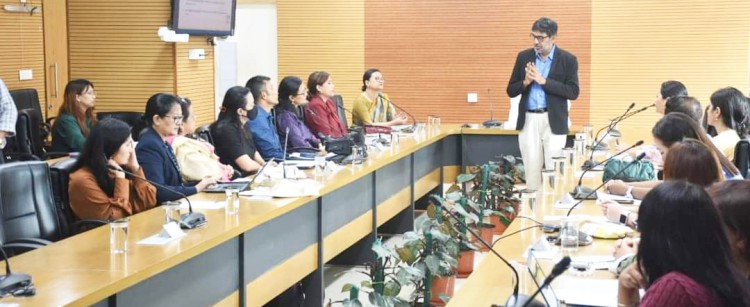




















Friday, Sep 13, 2024 09:30 [IST]
Last Update: Friday, Sep 13, 2024 03:59 [IST]
GANGTOK, (IPR): The three-day multi-stakeholder consultation on youth mental health and suicide prevention organised by Health & Family Welfare department under Sikkim INSPIRES programme in collaboration with the Centre for Mental Health Law and Policy successfully concluded today.
The workshop brought together key stakeholders including policymakers from Planning and Development department, Health & Family Welfare department, State Council of Educational Research and Training (SCERT) under Education department and Women and Child Development department, UNDP, non-profit organisations including Jhpiego and Freedom, representation from Tele MANAS under H&FW, civil society representatives, youth with lived experience and the team from Centre for Mental Health Law and Policy (CMHLP), Indian Law Society (ILS).
The final day featured a ‘Theory of Change’ consensus-building workshop, where participants shared the findings from the discussions held over the past three days since September 9.
After the initial context setting by Dr. Soumitra Pathare, director, CMHLP, Indian Law Society, the participants were briefed about the core objective of the workshop.
Amiti Verma, program manager and research fellow at CMHLP, made a brief presentation of the points discussed during the consultations.
It may be informed that consultations were held with government stakeholders on September 9 and the civil society stakeholders on September 10. These consultations focused on (a) drivers impacting youth mental health and suicide prevention in Sikkim, (b) institutional policy and service gaps for addressing youth mental health and suicide prevention in Sikkim, and (c) good practices and strategies for addressing youth mental health and suicide prevention in Sikkim.
Verma’s presentation highlighted the importance of the consultations and the workshop as crucial steps in creating a roadmap for addressing youth mental health and suicide prevention in Sikkim.
The presentation called attention to the priority areas that require focused attention over the next five years. The priority areas under the broad-based categories of systemic (policy and service) gaps, education, stigma and discrimination, changing lifestyles, family, relationship and community issues, and individual factors were discussed at length.
Subsequently, an engaging exercise was conducted with the participants to select key priority areas, following which, a discussion was held where participants were invited to share their suggestions regarding the points presented, within the context of Sikkim.
The Theory of Change (ToC) was elucidated by Arjun Kapoor, program director and senior research fellow at CMHLP. He explained that the Theory of Change (ToC) is a framework or roadmap that helps us define the change we want to achieve and outline the steps necessary to reach that goal.
A group exercise was conducted to identify the priority areas for the next five years in Sikkim.
The top priority areas were identified including "Family Problems and Communication Gaps”, "Enhancing the Ability of Young People to Cope with Stressors/Emotional Resilience” and “Materialism, Consumerism, Modern Lifestyles.”
The exercise also involved determining the necessary changes or outcomes in these areas over the given period. To achieve these changes, relevant activities and programs were outlined, along with strategies for their implementation through the Sikkim INSPIRES initiative.
It is anticipated that the entire process, encompassing the consultations and the ToC workshop, will result in the development of a bespoke framework specifically for Sikkim. This framework will map outcomes and interventions, serving as a guide for crafting a comprehensive action plan and roadmap for the proposed mental health and suicide prevention program in the region, as informed.
It was further informed, information and insights from the activities would be synthesised and presented as a draft report outlining the next steps and a plan of action. The draft report will outline (a) overview of the factors influencing mental health and suicide prevention in Sikkim, (b) agreed outcomes, activities and pathways for an inter-sectoral and integrated mental health and suicide prevention program and (c) proposed action plan identifying potential interventions, stakeholders and partnerships.
Towards the end of the workshop, participants contributed ideas, put forth suggestions, and reflected on whether their expectations were achieved. They expressed gratitude to the moderators, organisers, and facilitators for the valuable initiative on youth mental health and suicide prevention in Sikkim.
